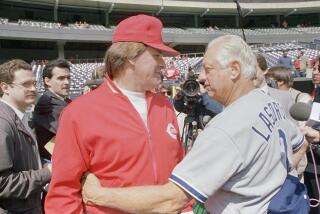The [Your Hobby Here] Hall of Fame
- Share via
WALCOTT, Iowa — At long last, this Midwestern prairie town of 1,528, settled more than a century ago by German and Scotch-Irish immigrants, will have a claim to fame.
Along a lonely slab of Interstate 80 about 175 miles east of Des Moines, the Trucking Hall of Fame is to hold its grand opening ceremony next summer, though the buildings already house about 100 trucks and trailers and have been welcoming school groups, Scouts and other locals for more than a year. One might call it a museum, but that wouldn’t convey the appropriate message, said Delia Moon Meier, whose family manages the site.
“The ‘Hall of Fame’ says a lot -- that the trucks are famous and the people that drove them are famous,” said Meier, 40. “We want to highlight some people who have done some incredible things.”
Her family also runs the adjacent Iowa 80 Truckstop, a 24-hour facility with parking spaces for 800 tractor-trailers that bills itself as the world’s largest truck stop.
Because of trucks, “you can have anything you’d ever want to eat all year round,” said Meier’s husband, Dave, 44, curator of the hall, whose impressive collection includes the 1924 White wrecker from the film “Fried Green Tomatoes.” “When I was a kid, there never was a salad bar.”
Trucking may finally be getting its due, but in terms of halls of fame, it’s late to the dance. These days, almost any occupation, any activity and any thing can boast of a hall of fame.
Accountants, clowns, Norwegian Americans, wheelchair basketball players, cowgirls, paper, ukuleles and cockroaches are but a handful of the subjects around which hundreds of halls of fames have sprung up in recent years as physical places or websites.
More are on the way.
A 1920s building near the riverfront in Cincinnati is undergoing a multimillion-dollar rehab for the Beer Hall of Fame, to open in spring 2007. Plans call for pumping sand onto the rooftop to create a beachside watering hole, while on other floors organizers will replicate a German beer garden and a Hong Kong-style karaoke bar.
In New Jersey, the state Senate passed a measure in May to establish a hall of fame for its most famous sons and daughters.
And five major cities are wooing NASCAR officials, who are looking to build an estimated $100-million hall of fame of their own, even though there is already the International Motorsports Hall of Fame in Talladega, Ala.; the Stock Car Racing Hall of Fame in Daytona Beach, Fla.; and the North Carolina Auto Racing Hall of Fame in Mooresville.
The list goes on. Apparently, 15 minutes of fame isn’t enough anymore -- Americans want to be famous forever.
“In an increasingly topsy-turvy world filled with uncertainty, a hall of fame gives people a sense of permanency,” said Gary Hoppenstand, editor of the Journal of Popular Culture. “It fills a basic human need of establishing an immortality.”
With fame seemingly everywhere, a hall of fame can be a way to distinguish oneself from the fleetingly famous. The halls also soothe one of America’s most notorious and ongoing insecurities -- am I good enough?
“We are a society tremendously concerned with prestige and certification,” said Hoppenstand, a professor of American studies at Michigan State University in East Lansing. “A hall of fame conveys that. It says whatever is inside is superior, it’s better.”
*
The halls weren’t always as common as stars on Hollywood’s Walk of Fame. Like most innovations, they began as something isolated that could have easily failed.
The nation’s first edifice to eternal eminence was the Hall of Fame for Great Americans, founded in 1900 at New York University’s old campus in the Bronx. With a neoclassic design by acclaimed architect Stanford White, the hall’s semicircular, 630-foot, open-air colonnade with bronze busts of inductees recalls the grandeur, and idol worship, of the ancient world.
Its original mission was to glorify national heroes, in part to unify a country still divided by the Civil War. An esteemed committee determined entrance into the hall. Qualifications were simple: You had to be highly accomplished, usually in politics, literature or industry, and dead for at least 25 years.
Induction ceremonies drew presidents, movie stars and other leading cultural luminaries, and were soon performed for the likes of Thomas Jefferson, Ralph Waldo Emerson and Alexander Graham Bell.
Pop culture was slow to pick up on the idea before eventually running off with it. The notion of fame broadened in 1939 with the unveiling of the Baseball Hall of Fame in Cooperstown, N.Y. In keeping with the athletic trend, Canton, Ohio, welcomed in 1963 the Pro Football Hall of Fame, and Springfield, Mass., did the same in 1968 for pro basketball.
Thanks to the popularity of these major sports, this triumvirate of old-school halls of fame attracted widespread attention and tens of thousands, sometimes hundreds of thousands, of annual visitors. More important to the development of these fame-based institutions was the halls’ ability to catapult once-obscure towns into the perpetual spotlight.
“You don’t even have to say a player is going to the Hall of Fame anymore; you can just say he’s going to Canton and everybody knows what you mean,” said Joe Horrigan, vice president of communications for the Pro Football Hall of Fame. “From a chamber of commerce perspective, it’s given a medium-sized city an identity.”
While halls of fame put some cities on the map, the term itself became embedded into the vernacular as the highest status one could achieve. Stars, even superstars, come and go, but a hall of famer is forever.
These shifts set the stage in the late 1980s and early 1990s for what amounted to a cultural deregulation of fame, coinciding with the founding of scores of halls of fames across the country.
The mass media fueled the fame explosion as they sought to satisfy their ravenous appetite for material that fed off of the flavor of the month, which quickly became the flavor of the week, and so on.
Suddenly, with markets for fame wide open, entree to a hall wasn’t limited to a precious few immortals anointed by an august board of elders. It was for everyone.
As such, fame was no longer linked to achievement, but could be had by being in front of the camera at the right time. When people like O.J. Simpson houseguest Kato Kaelin or heiress and Internet sex star Paris Hilton become household names, it’s easy to understand how a hall of fame for celebrity lingerie is created, cultural observers say.
“The modern fame industry really was born with the studio system, but then came television and it grew exponentially,” said Joshua Gamson, a sociologist at the University of San Francisco and author of “Claims to Fame: Celebrity in Contemporary America.” “It led to a newer version of fame, where it could be artificially produced and it didn’t require the person be particularly accomplished or the best at anything.”
So if marginal celebrity can earn you a moment in the sun, why not a hall of fame for, say, San Francisco-style polka? If pursuit of happiness was written into the Declaration of Independence in the 18th century, then why not the pursuit of fame in the 21st?
*
To be sure, criteria for induction can vary greatly. Standards for the big three sports -- baseball, football and basketball -- are stringent and can lead to controversy (for example, whether the fact that slugger Rafael Palmeiro evidently used steroids should keep him out, despite hall-worthy achievement). Of the thousands who have played major league baseball, only 260 have been enshrined. Veteran beat reporters in each sport typically make the call as they evaluate a career for productivity, consistency and milestone achievements.
Meanwhile, at the Beer Hall of Fame, it basically takes a friend’s nomination to be admitted.
“We’re looking for passion,” said Dennis Buettner, an organizer for the Beer Hall of Fame. “When, say, your buddy Bob gets inducted, we want that to be the most unbelievable experience of his life. So when he goes back to work on Monday and someone asks if he got his 15 minutes of fame, he’s going to say, ‘Heck yeah.’ ”
At the Trucking Hall of Fame, trucks are to be selected for their historical value, in terms of design, technology or reliability, the Meiers said. For drivers, selection is less clear-cut, but will probably include a long career with an outstanding safety record and good citizenship.
“There are guys that have been at it for 30 or 40 years, driven more than 4 million miles and never had an accident,” Dave Meier said. “You think about how far that is and it’s astounding.”
In some cases, a hall of fame can translate into more than a new and improved image -- it can also mean more money.
The Rock and Roll Hall of Fame in Cleveland, which opened in 1995, has pumped about $100 million into the local economy, city officials say.
Of course, the vast majority of halls cannot expect such windfalls for a hall or its community. For instance, the Quilters Hall of Fame, which held its grand opening last summer, has yet to blanket Marion, Ind., with fame and fortune. The Trucking Hall of Fame expects a modest financial gain, in part from a gift shop.
“Iowa starts the little museums as you’re driving west on 80,” said Delia Moon Meier, whose father’s dream was to create the Trucking Hall of Fame. “But there’s very little to see until you reach Nebraska. This just fits our customer base: people who want to stop and look at interesting things for a couple hours and then get back on the road.”
Despite how numerous they are, halls of fame can bestow a great sense of pride among honorees.
Jim Butler, 82, cherishes the memory of being the first person inducted into the North Carolina Pork Council’s Hall of Fame in 1989.
“I was almost speechless, which is unusual for me,” joked the pork council’s first executive director.
“I still don’t think I should have been the first person elected,” he said. “It should have gone to somebody who was actually producing hogs.”
More to Read
Sign up for The Wild
We’ll help you find the best places to hike, bike and run, as well as the perfect silent spots for meditation and yoga.
You may occasionally receive promotional content from the Los Angeles Times.






